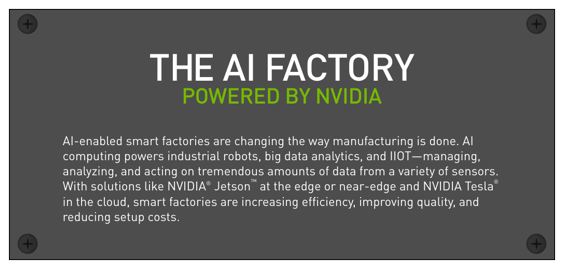 |
| By Jon Markman |
Fair warning, the next frontier in artificial intelligence is on the horizon. Investors should now prepare for “AI Factories.”
At the recent GPT Technology Conference, Nvidia (NVDA) executives talked endlessly about AI Factories, the software that will revolutionize development of future products.
And rightfully so, because …
AI Factories Change the Game
To understand AI Factories, it’s easiest to think in terms of traditional manufacturing plants.
Legacy factories are a symbiosis of materials, machinery and labor. Corporations combine all three to make everything from Ford F-150s to iPhones. AI Factories continuously create software to streamline the production of those products.
Continuous iteration of software enables the machines to learn from the data being created during production. Software begins to write software, negating the need for costly human engineering.
This may seem like science fiction. It is not that.

The big bang moment in AI occurred in 2012, when AlexNet used Nvidia’s CUDA software platform to profoundly change the nature of software.
AlexNet was a computer vision application informed by data. The novelty was the data produced new software on the fly, as opposed to relying on input from human developers.
It was the first instance of software autonomy — code writing code. Developers christened the moment at Software 2.0. AI development since then has been exponential.
AI is currently relegated to the digital world. However, AI factories bring the technology into the physical world. It is an opportunity that could be worth $100 trillion, according to Jensen Huang, Nvidia’s forward-thinking CEO.
Huang told CNBC in March 2023 that Nvidia is working with 700 corporations involved in transportation, robotic surgery, warehouse automation, manufacturing and energy. These firms are creating digital twins of their physical facilities in the Omniverse, a physics-simulated digital world where the AI Factories live.
This is a classic Nvidia move.
Executives at the San Jose, California-based company create completely new categories around Nvidia’s core competencies.
AI Factories need computing muscle, vast amounts of digital data and an algorithmic framework to build decision-making models. Nvidia has best-in-class GPU processors, fast networking for data transfer and the CUDU software platform. Nvidia owns the entire stack.
However, it still needs partners …
Nvidia Partners on AI Deployment
Nvidia and Pure Storage (PSTG) began working together in 2018 on AIRI, an AI toolkit for large-scale AI deployments.
AIRI marries Nvidia's DGX computer systems with Pure Storage's FlashBlade//S data storage solutions.

The toolkit has been pitched to corporate technology officers as a way to quickly build scalable AI projects with compatible components from trusted sources, a simplified management system and a focus on data security.
Pure Storage was the right partner. The company built an excellent reputation with firms like Meta Platforms (META), AutoNation (AN) and SiriusXM by specializing in all-flash, high-performance data storage solutions.
Pure Storage deployments keep corporate data close — either on premise or within the Pure Storage cloud, where the information can be managed through a set of application programming interfaces.
And the all-flash data storage means the information is stored only in flash memory … and not on traditional spinning disk drives. Flash is much faster and more energy efficient than traditional mechanical disk drives.
Speeding up retrieval times is critical for AI Factories.
Many AI models are frozen in time because they are trained using data that is stale. Asking ChatGPT about the weather tomorrow can result in some strange responses, even when the answer should be relatively simple.
Retrieval augmented generative, or RAG, AI — tech developed by Pure Storage — solves this problem by pointing the model toward a trusted source where the data is safely stored.
In addition to reliability, RAG also makes AI solutions more power efficient, manageable and faster.
All these factors will become pivotal as AI moves from large language models responsible for Chatbots to factories helping with software for remote surgery … or managing electric utility facilities.
Nvidia remains out in front of the biggest trends and shifts in AI uses. But it still needs partners to make it all happen.
Keep an eye here. This story isn’t over by a long shot. There are several new Nvidia partners on which you can still get in at the ground floor.
All the best,
Jon D. Markman
P.S. Nvidia isn’t the only tech frontrunner that is bringing along new partners for even bigger gains. In fact, in cryptocurrency, Bitcoin’s major impacts are helping to drive a select group of “new crypto wonders” to even higher highs. Click here for the full scoop.

